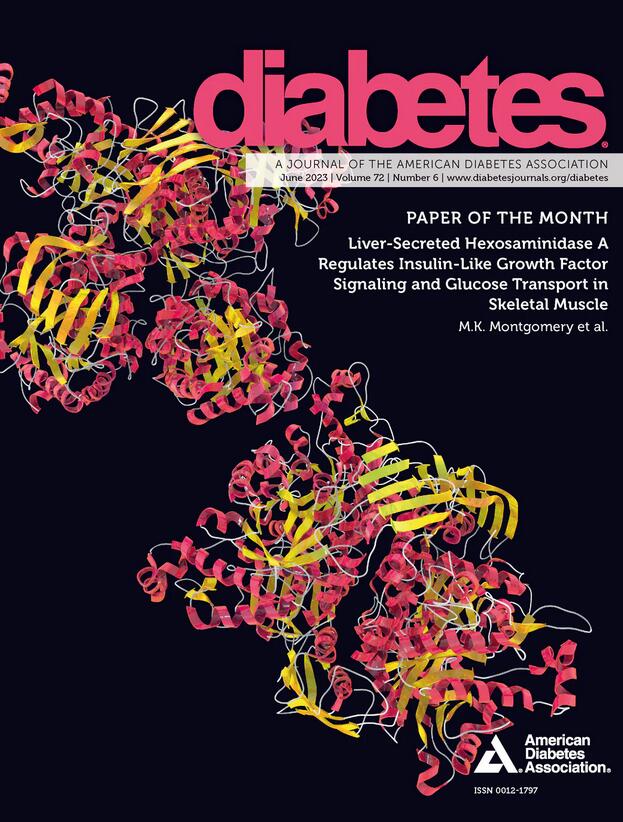2077-LB: Effects of Exposure to Gestational Diabetes on Hypothalamic Function, Food Intake, and Adiposity
IF 7.5
1区 医学
Q1 ENDOCRINOLOGY & METABOLISM
引用次数: 0
Abstract
Introduction and Objective: Prenatal exposure to gestational diabetes mellitus (GDM) increases obesity risk. Animal models suggest GDM exposure alters hypothalamic development, increasing food intake and adiposity. This study examined how GDM exposure affects hypothalamic function, dietary intake, and body fat in children from the BrainChild Cohort. Methods: We analyzed 134 children (57% female; 70 GDM-exposed, 64 unexposed) at baseline (8.6±1 yrs, 90% pre-pubertal) and 1-year follow-up (66% pre-pubertal). Functional MRI assessed hypothalamic response to glucose at baseline. At both time points, dietary intake was measured using 24-hour recalls and body fat via bioelectrical impedance. Linear models examined group differences at baseline and year 1, while mixed-effects models analyzed pooled data across time points, adjusting for age and sex. Results: GDM-exposed children had a higher hypothalamic response to glucose than unexposed children (β=0.08±0.04, p=0.01). At both time points, GDM-exposed children had higher caloric intake and body fat (p<0.05). Pooled analyses from baseline and Y1 showed GDM exposure was associated with higher body fat (β=4±1.5%, p=0.01), total energy intake (β=177±62.4 kcal, p=0.02), carbohydrate (β=18.5±8.8 g, p=0.04), sugar (β=10.9±5.5 g, p=0.05), and fat intake (β=7.5±3.4 g, p=0.03), with no differences in protein or fiber. Greater hypothalamic response to glucose was linked to increased body fat (β=3.8±2.2, p=0.09). Adjusting for hypothalamic response attenuated the association between GDM exposure and body fat (β=4.0±1.5→β=2.9±1.6), with further attenuation after adjusting for diet (β=4.0±1.5 →β=2.6±1.7). Diet alone did not affect this relationship. Conclusion: By age 8.5 years, GDM-exposed children exhibit altered hypothalamic responses to glucose, higher energy intake (particularly sugar and fat), and greater body fat, with effects persisting over one year. These findings highlight the role of the hypothalamus in linking GDM exposure to adiposity in children. Disclosure E.C. Morgan: None. J.M. Alves: None. T. Chow: None. A. Xiang: None. K.A. Page: None. Funding American Diabetes Association (1-14-ACE-36); NIH (R01DK134079, RO1DK116858)妊娠期糖尿病对下丘脑功能、食物摄入和肥胖的影响
前言与目的:产前暴露于妊娠期糖尿病(GDM)可增加肥胖风险。动物模型显示GDM暴露改变下丘脑发育,增加食物摄入和肥胖。本研究考察了GDM暴露对BrainChild队列儿童下丘脑功能、饮食摄入和体脂的影响。方法:对134例儿童进行分析,其中57%为女性;基线(8.6±1年,90%为青春期前)和1年随访(66%为青春期前)时gdm暴露者70例,未暴露者64例。功能性MRI评估下丘脑对葡萄糖的基线反应。在这两个时间点,通过24小时回忆和生物电阻抗测量饮食摄入量和体脂。线性模型检查了基线和第一年的组间差异,而混合效应模型分析了跨时间点的汇总数据,调整了年龄和性别。结果:gdm暴露儿童下丘脑对葡萄糖的反应高于未暴露儿童(β=0.08±0.04,p=0.01)。在两个时间点,gdm暴露儿童的热量摄入和体脂均较高(p < 0.05)。基线和Y1的汇总分析显示,GDM暴露与较高的体脂(β=4±1.5%,p=0.01)、总能量摄入(β=177±62.4 kcal, p=0.02)、碳水化合物(β=18.5±8.8 g, p=0.04)、糖(β=10.9±5.5 g, p=0.05)和脂肪摄入(β=7.5±3.4 g, p=0.03)相关,蛋白质和纤维无差异。下丘脑对葡萄糖的更大反应与体脂增加有关(β=3.8±2.2,p=0.09)。调整下丘脑反应减弱了GDM暴露与体脂之间的关联(β=4.0±1.5→β=2.9±1.6),调整饮食后进一步减弱(β=4.0±1.5→β= 2.6±1.7)。饮食本身不会影响这种关系。结论:到8.5岁时,gdm暴露的儿童表现出对葡萄糖的下丘脑反应改变,能量摄入(特别是糖和脂肪)增加,体脂肪增加,影响持续一年以上。这些发现强调了下丘脑在GDM暴露与儿童肥胖之间的作用。摩根:没有。J.M.阿尔维斯:没有。周星驰:没有。A. Xiang:没有。佩奇:没有。资助美国糖尿病协会(1-14 ace -36);Nih (r01dk134079, ro1dk116858)
本文章由计算机程序翻译,如有差异,请以英文原文为准。
求助全文
约1分钟内获得全文
求助全文
来源期刊

Diabetes
医学-内分泌学与代谢
CiteScore
12.50
自引率
2.60%
发文量
1968
审稿时长
1 months
期刊介绍:
Diabetes is a scientific journal that publishes original research exploring the physiological and pathophysiological aspects of diabetes mellitus. We encourage submissions of manuscripts pertaining to laboratory, animal, or human research, covering a wide range of topics. Our primary focus is on investigative reports investigating various aspects such as the development and progression of diabetes, along with its associated complications. We also welcome studies delving into normal and pathological pancreatic islet function and intermediary metabolism, as well as exploring the mechanisms of drug and hormone action from a pharmacological perspective. Additionally, we encourage submissions that delve into the biochemical and molecular aspects of both normal and abnormal biological processes.
However, it is important to note that we do not publish studies relating to diabetes education or the application of accepted therapeutic and diagnostic approaches to patients with diabetes mellitus. Our aim is to provide a platform for research that contributes to advancing our understanding of the underlying mechanisms and processes of diabetes.
 求助内容:
求助内容: 应助结果提醒方式:
应助结果提醒方式:


